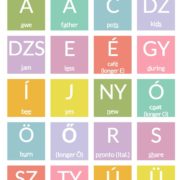Mini Hungarian Lesson: Learn the Hungarian Present Tense (in 30 Minutes)
The Hungarian present tense is easier than you may think. In this mini lesson you will learn the grammar rules and the concepts in about 30 minutes. We break it down for you and show you everything you need (including many examples and memory hooks) for a quick learning experience.
While the Hungarian grammar is often the cause for serious headaches, it also has its shiny and sunny sides. Good news: Conjugating verbs in the present tense is one of them:
- Hungarian only has one present tense.
There is no differentiation between simple and a continuous present as in other languages such as English, Spanish or Italian.
“I go to the market.” and “I am going to the market.”
can be expressed in Hungarian with the same conjugation form; adding “most” (=now) or “éppen” (=right now) is enough:
“Megyek a piacra.” vs. “Most / Èppen megyek a piacra.”
- Most of the Hungarian verbs are regular.
There are no more than 23 irregular verbs in Hungarian. You can find a list of them for example on the page of this useful Hungarian verb conjugator.
(Note however that some of the most important verbs such as “van” (lenni, ‘to be’); “megy” (menni, ‘to go’); “jön” (jönni, ‘to come’); “eszik” (enni, ‘to eat’), are irregular!)
But the good thing is, that as soon as you understand the rules for the regular verbs (which we’ll explain and break down for you in this article), also the irregular verbs are easier to remember, because most of the time only some small differences are to be memorised.
- The Hungarian present tense can be used for future actions as well.
“Tomorrow I will go to the market.” – “Holnap megyek a piacra.”
By mastering the Hungarian present tense you’ll kill two birds (ie. sentences) with one stone!
We have subdivided this mini-lesson into the following sections:
What you Need to Learn beforehand
2. The Indefinite Conjugation of the Hungarian Present Tense
3. The Definite Conjugation of the Hungarian Present Tense
What you Need to Learn Beforehand
The only thing you need to know/learn beforehand for this lesson is the Hungarian Alphabet and the Hungarian vowel harmony.
And of course you should know what “conjugation” is (since that’s what this article is about).
Broadly speaking, verb conjugation is the changing of a verb’s form to express a different person (I, you(sing.), he / she / it, we, you(pl.), they) and its tense. In that way, a conjugated verb can tell us who is doing the action and when.
English is blessed with a very easy conjugation:
“I”, “you”, “we”, “you” and “they” all “GO”; only “he”, “she” and “it” “GOES”.
In many other languages (including Hungarian), the verb changes with every grammatical person:
E.g. “Èn megyek.” (I go) vs. “Te mész” (You go.), etc.
In this lesson, we will show you what you have to look out for and how to remember the rules best.
But that’s enough of introduction; let’s dive straight in and start your stopwatch!
1. Learn the Difference between the Indefinite and Definite Conjugation of the Hungarian Present Tense
One of the tricky specialties of the Hungarian present tense is that there are two different conjugation forms depending on the object of the sentence/statement:
- When you talk about an unspecific/unknown/indefinite thing or person, you conjugate the verb with the indefinite suffixes (word endings).
- When you talk about a specific/definite thing or person, you conjugate the verb with the definite suffixes (word endings).
The use of the definite article “a(z)” (“the”) and/or the pronouns “az” and “ez” (this and that) are good indicators to use the definite conjugation.
Let’s see an example:
Indefinite conjugation: “I see a flower.” – “Látok egy virágot.”
Definite conjugation: “I see the flower.” – “Látom a virágot.”
In reality it is a bit more complicated than that (dry and boring grammar books are good proof), but in most of the cases this is enough. And even if you confuse the conjugation forms, everyone will still understand you. Even Hungarians themselves confuse the two forms sometimes, so there’s really no need to worry.
33 HUNGARIAN HISTORIES – Get our EBOOK
Understand the Hungarian Mentality through 33 Captivating Stories of Inherently Magyar Personalities
Whether you’re in search of your Hungarian roots, are living in or travelling to Hungary or you’re just curious about the history of this tiny but ever-proud nation – this book is for you.
2. The Indefinite Conjugation of the Hungarian Present Tense
For a better understanding we subdivided this chapter into the following 7 sections:
- Regular verbs with back vowels
- Regular verbs with front vowels
- Regular verbs with connecting vowels
- Verbs ending in -ik
- Verbs ending in -s, -sz, -z
- Verbs ending in -sik, -szik, -zik
- Irregular verbs
2.1 Regular verbs with back vowels
The regular verbs with back vowels are the biggest chunk. All other verb groups can be deviated from these.
Don’t worry, as we will also help you to memorise the endings with some smart memory hooks, so you will master them in no time.
The following table shows the indefinite conjugation of the verb “tudni”, representing the the back vowel verbs.
The suffixes/endings, which you’ll have to memorise, are marked in red:
Person | back vowels | front vowels | ö, ő, ü, ű in last syllable |
|---|---|---|---|
| tud(ni) to know | * | * | |
| Én | tud-ok | * | * |
| Te | tud-sz | * | * |
| Ő /Ön | tud- | * | * |
| Mi | tud-unk | * | * |
| Ti | tud-tok | * | * |
| Ők / Önök | tud-nak | * | * |
| Én -> téged, titeket | tud-lak | * | * |
*see next chapter
Memory hooks and deconstruction for easier/quicker learning:
- In almost every conjugations (except for “Te” and “Ő/Ön”) there is a “k ” at the end of the suffix (with this in mind, you already learned more than 30% of the letters of the suffixes in this chapter!)
- Én: “-ok” is easy to remember, because “I’m OK with it.”
- Te : “-sz“ –> pronounced like the s in Second Person Singular.
- Ő / Ön: – –> no suffix; this one is our absolute favourite!
- Mi: “-unk“. If you turn around the first ark of the m (in “mi”) you get an “un“, which you simply have to combine with the omnipresent “k“.
- Ti: take the “t” from “ti” and combine it with the “ok“ (which you already know from “Èn”)
- Ők / Önök: “-nak“. Just imagine that they are all naked.
- Én -> téged, titeket: “-lak“ –> replace the “n“ in “nak” with an “l” (think of the “L” in “Love you”). Note that “téged” and “titeket” means “you” (in singular and plural). “-lak“ is a Hungarian specialty/feature and expresses the relationship between I and you (singular or plural), e.g. “I see you.” can be translated to “lát-lak“.
Done! That wasn’t so bad, was it?
2.2 Regular Verbs with Front Vowels
Now let’s have a look at the front vowels (which includes the words with ö, ő, ü, ű in last syllable):
Person | back vowels | front vowels | ö, ő, ü, ű in last syllable |
|---|---|---|---|
| tud(ni) to know | Szeret(ni) to love | ül(ni) to sit | |
| Én | tud-ok | szeret-ek | ül-ök |
| Te | tud-sz | szeret-sz | ül-sz |
| Ő /Ön | tud- | szeret- | ül- |
| Mi | tud-unk | szeret-ünk | ül-ünk |
| Ti | tud-tok | szeret-tek | ül-tök |
| Ők / Önök | tud-nak | szeret-nek | ül-nek |
| Én -> téged, titeket | tud-lak | szeret-lek | * |
*ül has no conjugation for Én -> téged, titeket (since “I sit you” doesn’t make sense).
As you can see, the endings above run things by the following “vowel rule“:
(This is not an official rule; it’s just a concept we found useful.)
| back vowels | front vowels | ö, ő, ü, ű in last syllable | |
|---|---|---|---|
| a | e | e | |
| o | e | ö | |
| u | ü | ü |
Memory hooks to remember the “vowel rule”:
- the transformation of the “u“ is the easiest to remember, only add two dots to get the “ü” for the front vowels (incl. ö, ő, ü, ű)
- same for the a, but since there is no ä in Hungarian, the a is transformed into e (which comes closest to the ä)
- the o is always a bit indecisive and in love with the a, therefore it is transformed into e and ö .
That’s basically it!
Keep in mind that you only have to memorize the endings for the back vowels; the front vowels (incl. ö, ő, ü, ű) follow the simple “vowel rule”.
By now, the biggest chunk is through, the rest is a walk in the park.
2.3 Regular Verbs with Connecting Vowels
Verbs ending with two consonants (e.g. “mond“) or “-ít” (e.g. segít) get an additional vowel in some conjugations in order to simplify the pronunciation.
Also the infinitive form gets an additional vowel, e.g. mond(ani) and küld(eni).
Sounds complicated, but it’s really not that big of a deal.
Let’s have a look at some examples (connecting vowel marked in red) to get the concept:
Person | back vowels | front vowels | ö, ő, ü, ű in last syllable |
|---|---|---|---|
| mond(ani) to say | segít(eni) to help | küld(eni) to send | |
| Én | mond-ok | segít-ek | küld-ök |
| Te | mond-asz | segít-esz | küld-esz |
| Ő /Ön | mond- | segít- | küld- |
| Mi | mond-unk | segít-ünk | küld-ünk |
| Ti | mond-otok | segít-etek | küld-ötök |
| Ők / Önök | mond-anak | segít-enek | küld-enek |
| Én -> téged, titeket | *-alak | segít-elek | küld-elek |
The good thing is that the connecting vowels are following simple rules:
- Only the endings which start with a consonant need a connecting vowel (that certainly makes sense); therefore nothing changes for “Én”, “Ő/Ön” and “Mi”
- “Te”: the back vowel “a” is added for back vowel verbs; and can be transformed with our “vowel rule”: –asz / –esz / –esz
- for the other personal forms just clone the existing vowel in the ending:
- Ti: –otok / –etek / –ötök
- Ők / Önök: –anak / –enek / –enek
- Én -> téged, titeke: –alak / –elek / –elek
- Ti: –otok / –etek / –ötök
2.4 Verbs Ending in -ik
There are only two things to remember, and one of them is optional:
- the suffix (ending) is added to the verb-stem, and not after the -ik.
e.g. it’s “lak-ok”, and not “lakik-ok”.
- For “Én” 2 forms are possible; both are correct:
- -ok/-ek/-ök is the form we already know. Nothing new here so far, but if you are super motivated you can use the next form as well:
- –om / –em / –öm –> just replace the “k” with an “m” and get the new suffix, which at the same time corresponds to the definite conjugation form (you will see in chapter 3.1).
- -ok/-ek/-ök is the form we already know. Nothing new here so far, but if you are super motivated you can use the next form as well:
An example is worth a thousand words:
| Person | back vowels | front vowels | ö, ő, ü, ű in last syllable |
|---|---|---|---|
| lakik (lakni) to live [reside] | történik (történni) to happen | vörösödik (vörösödni) to redden | |
| Én | lak-ok lak-om | történ-ek történ-em | vörösöd-ök vörösöd-öm |
| Te | lak-sz | történ-sz | vörösöd-sz |
| Ő /Ön | lak-ik | történ-ik | vörösöd-ik |
| Mi | lak-unk | történ-ünk | vörösöd-ünk |
| Ti | lak-tok | történ-tek | vörösöd-tök |
| Ők / Önök | lak-nak | történ-nek | vörösöd-nek |
| Én -> téged, titeket | * | * | * |
2.5 Verbs ending in -s, -sz, -z
- Only “Te” is affected here.
- adding a “-sz” after a “-s/-sz/-z” would hurt the harmony-spoiled Hungarian ear, therefore the ending “-ol” is used instead (for back vowel verbs)
Why “-ol“? most probably because it’s partly cool! - for the front vowel verbs of course our “vowel rule” can be applied: –ol -> –el -> –öl
- adding a “-sz” after a “-s/-sz/-z” would hurt the harmony-spoiled Hungarian ear, therefore the ending “-ol” is used instead (for back vowel verbs)
| Person | back vowels | front vowels | ö, ő, ü, ű in last syllable |
|---|---|---|---|
| HOZ(NI) TO BRING | VESZ(NI) TO BUY | TŰZ(NI) TO PIN | |
| Én | hoz-ok | vesz-ek | tűz-ök |
| Te | hoz-ol | vesz-el | tűz-öl |
| Ő /Ön | hoz- | vesz- | tűz- |
| Mi | hoz-unk | vesz-ünk | tűz-ünk |
| Ti | hoz-tok | vesz-tek | tűz-tök |
| Ők / Önök | hoz-nak | vesz-nek | tűz-nek |
| Én -> téged, titeket | hoz-lak | vesz-lek | tűz-lek |
2.6 Verbs ending in -sik, -szik, -zik
Nothing new here; it’s only a combination of the -ik verbs (see 2.4) and with –s, -sz, -z (see 2.5).
But see for yourself:
Person | back vowels | front vowels | ö, ő, ü, ű in last syllable |
|---|---|---|---|
| mászik (mászni) to climb | esik (esni) to fall | ütközik (ütközni) to clash | |
| Én | mász-ok mász-om | es-ek es-em | ütköz-ök ütköz-öm |
| Te | mász-ol | es-el | ütköz-öl |
| Ő /Ön | mász-ik | es-ik | ütköz-ik |
| Mi | mász-unk | es-ünk | ütköz-ünk |
| Ti | mász-tok | es-tek | ütköz-tök |
| Ők / Önök | mász-nak | es-nek | ütköz-nek |
2.7 Bonus: Irregular Verbs
The irregular verbs are actually not part of this mini lesson, since they don’t follow all of the above rules.
But as you will see, as soon as you know the rules, also the irregular verbs are much easier, because actually they don’t break every rule.
But convince yourself:
Person | back vowels | front vowels | ö, ő, ü, ű in last syllable |
|---|---|---|---|
| van (lenni) to be | megy (menni) to go | nő (nőni) to grow | |
| Én | vagy-ok | megy-ek | növ-ök |
| Te | vagy | mé-sz | nő-sz |
| Ő /Ön | van | megy | nő |
| Mi | vagy-unk | megy-ünk | növ-ünk |
| Ti | vagy-tok | men-tek | nőt-tök |
| Ők / Önök | van-nak | men-nek | nő-nek |
A list of all 23 irregular verbs can be found on the page of this useful Hungarian verb conjugator.
3. The Definite Conjugation of the Hungarian Present Tense
This chapter is subdivided into the following 3 sections:
1. Regular verbs (with and without connecting vowels)
2. Verbs ending with -s, sz, -z
3.1 Regular verbs (with and without connecting vowels)
Let’s start with the regular verbs of definite conjugation:
Person | back vowels | front vowels | ö, ő, ü, ű in last syllable |
|---|---|---|---|
| tud(ni) – to know | Szeret(ni) – to love | ül(ni) – to sit | |
| Én | tud-om | szeret-em | ül-öm |
| Te | tud-od | szeret-ed | ül-öd |
| Ő /Ön | tud-ja | szeret-i | ül-i |
| Mi | tud-juk | szeret-jük | ül-jük |
| Ti | tud-játok | szeret-itek | ül-itek |
| Ők / Önök | tud-ják | szeret-ik | ül-ik |
Memory Hooks:
- Èn: –om, –em, –öm. Just replaced the “k” (from the indefinite suffixes -ok /-ek /-ök) with an “m“.
- Te: is a bit odd: the ending is “–od“ (for back vowels)
For front vowels our “vowel rule” can be applied: –ed/-öm
From now on Hungarian will unfold its full beauty (by refusing most of the rules we learned so far).
Get ready to use many “i”-s and “j”-s!
- Ő /Ön is formed with –ja / –i /-i . Even after contemplation we didn’t find a systematic reason why the hell the Hungarian grammar fairy had to switch to –ja / –i /-i. At least it is easy to remember and will be used not just for Ő / Ön.
- Mi: similar to the indefinite -unk, / -ünk / -ünk but with a “j” at the beginning instead of the “n“ in the middle:
–juk / –jük / –jük
- Ti: and here we meet our newly found love “-ja / –i /-i” again, in combination with the indefinite “-tok -/tek /-tök”.
–> “-jatok / –itek / –itek”. Why not “itök”? Don’t blame us, blame the Hungarian grammar fairy!
- Ők / Önök: We are so happy that we can close this with an easy one: Since “Ők” is the plural of “Ő” it makes sense to add a “k” to the Ő-suffixes, so we get “-jak / –ik / –ik“.
3.2 Verbs ending with -s, sz, -z
This is nothing you have to memorise; this is something you just have to understand, and luckily it’s not complicated:
In order to harmonise the pronunciation every -sj, szj and zj is transformed in -ss, -ssz and -zz.
e.g. instead of “Ő olvasja” it is “olvassa”,; instead of “Mi hiszjük” it’s “hisszük”.
You get the idea… Here are some more examples:
Person | back vowels | front vowels | ö, ő, ü, ű in last syllable |
|---|---|---|---|
| hoz(ni) to bring | vesz (venni) to buy | tűz(ni) to pin | |
| Én | hoz-om | vesz-em | tűz-öm |
| Te | hoz-od | vesz-ed | tűz-öd |
| Ő /Ön | hozza | vesz-i | tűz-i |
| Mi | hozzuk | veszzük | tűzzük |
| Ti | hozzátok | vesz-itek | tűz-itek |
| Ők / Önök | hozzák | vesz-ik | tűz-ik |
3.3 Other Verb Forms
Good news: with these 2 groups above all the definite conjugation forms are basically covered!
All other verb forms (ik-verbs and irregular verbs) are almost never used with or don’t even have a definite conjugation!
Heureka, we did it!
Applying these rules above you will be able to master the Hungarian Present Tense.
Are we completely crazy to claim this can be learned/understood in approx 30 minutes? Please let us know!
Of course we are aware that it will take more time and practice than a mere 30 minutes to apply these rules fluently in a normal conversation.
Still, never let some grammar errors stop you from communicating, it absolutely doesn’t matter if you confuse one or the other conjugation. Trust us, even Hungarians confuse them sometimes!
And never forget the most important rule in language learning: HAVE FUN!
You might also like:
Mini Hungarian Lesson – Everything You Need to Know about “Meg”
Learn the Hungarian Alphabet in 4 Easy Steps!
Learn the Hungarian Numbers in 9 Easy Steps!
35 Good Reasons You Should Bother Learning Hungarian
23 Awesome Hungarian Words that Don’t Exist in English











I had a tough time getting a system down for theses grinding through duolingo because they don’t explain the definite vs indefinite conjugations on their app so this helps a lot!
Hi Tristan,
We are really happy that it was helpful! Thanks for the comment and letting us know 🙂
Keep up the learning and enjoy!
All the best,
Juli & Flo
This is the best explanation of present tense verbs I’ve come across. So well written and explained and the tables are great! Thanks so much!
I came here to say this. Completely agree. Great explanations, thankyou
typo:
“Èn” should be “Én”
suffix “jatok” should be “játok”